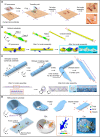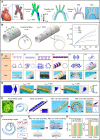Assembly of complex 3D structures and electronics on curved surfaces
- PMID: 35947653
- PMCID: PMC9365271
- DOI: 10.1126/sciadv.abm6922
Assembly of complex 3D structures and electronics on curved surfaces
Abstract
Electronic devices with engineered three-dimensional (3D) architectures are indispensable for frictional-force sensing, wide-field optical imaging, and flow velocity measurement. Recent advances in mechanically guided assembly established deterministic routes to 3D structures in high-performance materials, through controlled rolling/folding/buckling deformations. The resulting 3D structures are, however, mostly formed on planar substrates and cannot be transferred directly onto another curved substrate. Here, we introduce an ordered assembly strategy to allow transformation of 2D thin films into sophisticated 3D structures on diverse curved surfaces. The strategy leverages predefined mechanical loadings that deform curved elastomer substrates into flat/cylindrical configurations, followed by an additional uniaxial/biaxial prestretch to drive buckling-guided assembly. Release of predefined loadings results in an ordered assembly that can be accurately captured by mechanics modeling, as illustrated by dozens of complex 3D structures assembled on curved substrates. Demonstrated applications include tunable dipole antennas, flow sensors inside a tube, and integrated electronic systems capable of conformal integration with the heart.
Figures





Similar articles
-
Engineered elastomer substrates for guided assembly of complex 3D mesostructures by spatially nonuniform compressive buckling.Adv Funct Mater. 2017 Jan 5;27(1):1604281. doi: 10.1002/adfm.201604281. Epub 2016 Nov 2. Adv Funct Mater. 2017. PMID: 28970775 Free PMC article.
-
Design and Fabrication of Heterogeneous, Deformable Substrates for the Mechanically Guided 3D Assembly.ACS Appl Mater Interfaces. 2019 Jan 23;11(3):3482-3492. doi: 10.1021/acsami.8b19187. Epub 2019 Jan 8. ACS Appl Mater Interfaces. 2019. PMID: 30584766
-
Mechanically-Guided 3D Assembly for Architected Flexible Electronics.Chem Rev. 2023 Sep 27;123(18):11137-11189. doi: 10.1021/acs.chemrev.3c00335. Epub 2023 Sep 7. Chem Rev. 2023. PMID: 37676059 Free PMC article. Review.
-
Stimulus Responsive 3D Assembly for Spatially Resolved Bifunctional Sensors.Small. 2019 Dec;15(51):e1904224. doi: 10.1002/smll.201904224. Epub 2019 Nov 14. Small. 2019. PMID: 31724819
-
Micro/Nanoscale 3D Assembly by Rolling, Folding, Curving, and Buckling Approaches.Adv Mater. 2019 Sep;31(36):e1901895. doi: 10.1002/adma.201901895. Epub 2019 Jul 2. Adv Mater. 2019. PMID: 31265197 Review.
Cited by
-
Designs and Applications for the Multimodal Flexible Hybrid Epidermal Electronic Systems.Research (Wash D C). 2024 Aug 9;7:0424. doi: 10.34133/research.0424. eCollection 2024. Research (Wash D C). 2024. PMID: 39130493 Free PMC article.
-
Human-Centric, Three Dimensional Micro Light-Emitting Diodes for Cosmetic and Medical Phototherapy.Adv Sci (Weinh). 2025 Mar;12(10):e2416716. doi: 10.1002/advs.202416716. Epub 2025 Feb 17. Adv Sci (Weinh). 2025. PMID: 39960366 Free PMC article.
-
From in vitro to in vivo: Diverse applications of kirigami technology in medical devices.Mater Today Bio. 2025 Jun 11;33:101961. doi: 10.1016/j.mtbio.2025.101961. eCollection 2025 Aug. Mater Today Bio. 2025. PMID: 40585023 Free PMC article. Review.
-
Actuation-enhanced multifunctional sensing and information recognition by magnetic artificial cilia arrays.Proc Natl Acad Sci U S A. 2023 Oct 17;120(42):e2308301120. doi: 10.1073/pnas.2308301120. Epub 2023 Oct 4. Proc Natl Acad Sci U S A. 2023. PMID: 37792517 Free PMC article.
-
Vertical serpentine interconnect-enabled stretchable and curved electronics.Microsyst Nanoeng. 2023 Nov 27;9:149. doi: 10.1038/s41378-023-00625-w. eCollection 2023. Microsyst Nanoeng. 2023. PMID: 38025886 Free PMC article.
References
-
- Park Y., Chung T. S., Lee G., Rogers J. A., Materials chemistry of neural interface technologies and recent advances in three-dimensional systems. Chem. Rev. 122, 5277–5316 (2021). - PubMed
-
- Kim D.-H., Lu N., Ma R., Kim Y.-S., Kim R.-H., Wang S., Wu J., Won S. M., Tao H., Islam A., Yu K. J., Kim T.-i., Chowdhury R., Ying M., Xu L., Li M., Chung H.-J., Keum H., McCormick M., Liu P., Zhang Y.-W., Omenetto F. G., Huang Y., Coleman T., Rogers J. A., Epidermal electronics. Science 333, 838–843 (2011). - PubMed
-
- Byun S. H., Sim J. Y., Agno K. C., Jeong J. W., Materials and manufacturing strategies for mechanically transformative electronics. Mater. Today Adv. 7, 100089 (2020).
-
- Yu Y., Nyein H. Y. Y., Gao W., Javey A., Flexible electronics: Flexible electrochemical bioelectronics: The rise of in situ bioanalysis (Adv. Mater. 15/2020). Adv. Mater. 32, 2070115 (2020). - PubMed
LinkOut - more resources
Full Text Sources

